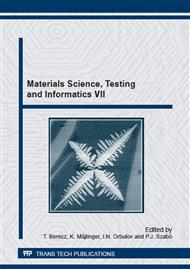p.333
p.339
p.345
p.351
p.357
p.363
p.369
p.375
p.381
Investigation of Intermetallic Phases Formed in Lead-Free Solders
Abstract:
Industry should gradually replace the tin-lead solder alloys used traditionally in the soft soldering technology by lead-free soldering alloys, which raises a lot of new technological and scientific problems to be solved. The introduction and application of lead-free alloys caused a number of soldering defects not observed earlier; mechanisms of their formation are still unclear. One of such defects is whisker formation, another one is intensified formation of intermetallic phases. The appearance of undesired intermetallic phases in the soldering material spoils its mechanical properties; therefore it is particularly important that these phases do not form in electronic components. Besides, the formation of intermetallic compounds may occur in the soldering bath, thus making the soldering process difficult or even impossible.Tin-copper-nickel and tin-silver-copper alloys are suitable for the replacement of tin-lead alloys. The components of these alloys were studied. After metallographic examination of the specimens the occurrence of intermetallic phases was determined by the XRD method. The identification of intermetallic phases was carried out by using literature data and phase diagrams.
Info:
Periodical:
Pages:
357-362
Citation:
Online since:
February 2015
Authors:
Keywords:
Price:
Сopyright:
© 2015 Trans Tech Publications Ltd. All Rights Reserved
Share:
Citation:


